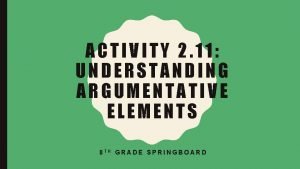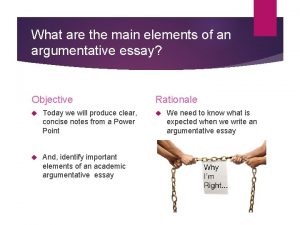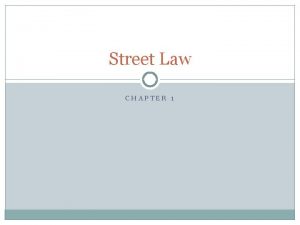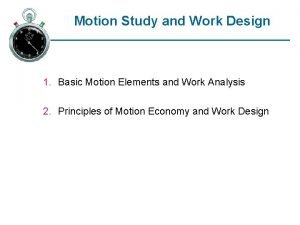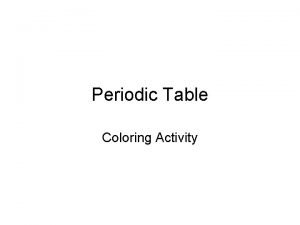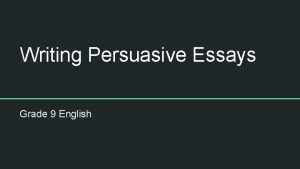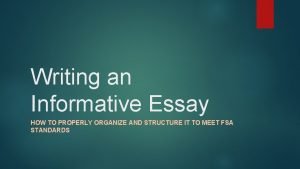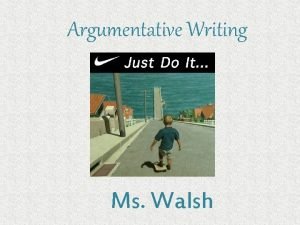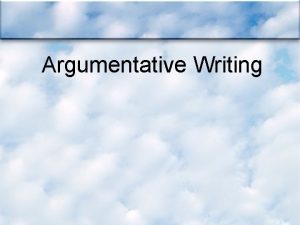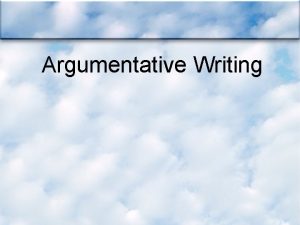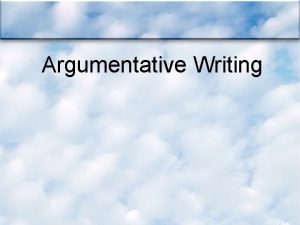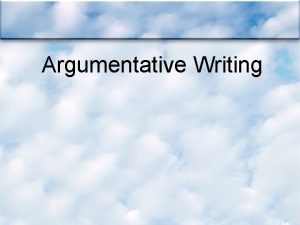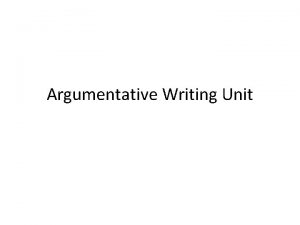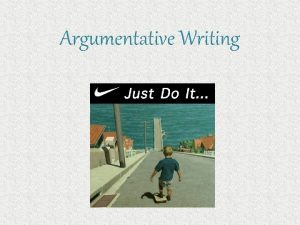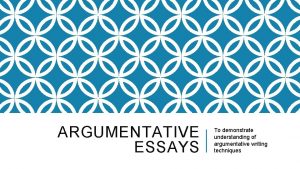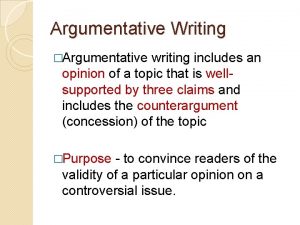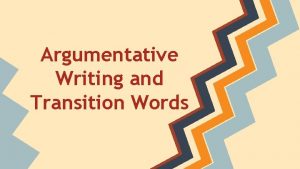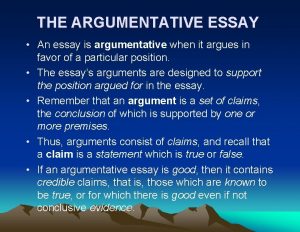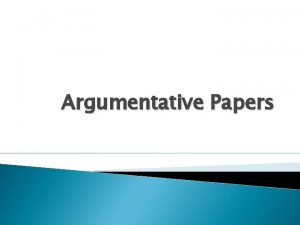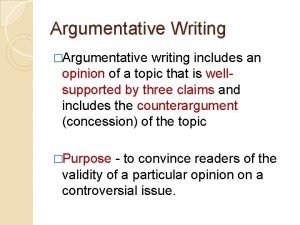ACTIVITY 2 11 UNDERSTANDING ARGUMENTATIVE ELEMENTS 8 TH






















- Slides: 22

ACTIVITY 2. 11: UNDERSTANDING ARGUMENTATIVE ELEMENTS 8 TH GRADE SPRINGBOARD

LEARNING TARGETS • I can evaluate a writer’s ideas, point of view, or purpose in an argumentative essay. • I can determine how the writer manages counterclaims. • I can identify and apply the six elements of

NOTEBOOK • Date 2. 11 Argumentation Vocab pg.

ARGUMENT • Is a logical appeal, supported by reasons and evidence, to persuade an audience to take action or agree with a point of view. There are 6 elements of argumentation.

PURPOSE • The specific reason(s) for writing or speaking. It is the goal the writer or speaker wishes to achieve. Ask yourself, “What is the point they’re trying to make? ”

AUDIENCE • The specific person or group of people the writer is trying to convince (the opposition); one must consider the audience’s values and beliefs before writing the argument.

CLAIM AN ASSERTION OF SOMETHING AS TRUE, REAL, OR FACTUAL.

EVIDENCE • Knowledge or data on which to base belief, used to prove truth or falsehood. • Evidence may include: – Testimony from experts – Research-based facts – Analogies (comparisons on similar situations) – References

REASONING • Logical conclusions, judgements, or inferences based on evidence.

COUNTERCLAIM • A claim based on knowledge of the other side of a controversial issue. • Used to demonstrate understanding of the audience, expertise in the subject, and credibility.

CONCESSION • A writer or speaker briefly recognizes the opposing viewpoint. REBUTTAL • Using evidence to argue against the opposing viewpoint.

PREVIEW • In this activity, you will read analyze an eighth grader’s argumentative essay.

SETTING A PURPOSE FOR READING • 1 st: Circle unknown words and phrases. Try to determine the meaning of the words by using context clues, word parts, or a dictionary. • 2 nd: Reading Markers • 3 rd: As you read the essay, use three different highlighters to identify the parts of the writer’s argument. Mark text evidence with the first color, reasoning with the second color, and counterclaims used to support the claim with the third color.

CRAFT AND STRUCTURE 1. What is the writer’s purpose? Who is the writer’s audience? How do you know? Use textual evidence to support your answer. The writer’s purpose is to convince the reader that employers should not access private information from a public website. The audience is employs and the general public. I can tell this because she uses persuasive, strong language, like “If we expect privacy in our real world life, shouldn’t we be able to have privacy in our online life as well? ”

KEY IDEA AND DETAILS 2. What is the writer’s claim? Is it clear to the audience? Use textual evidence to support your answer. The writer’s claim is that employers should not require employees to grant them access to private online pages. The writer directly states her claim at the end of the opening paragraph.

CRAFT AND STRUCTURE 3. Paragraph 2 mentions a counterclaim. Restate the counterclaim in your own words. What evidence and reasoning does the writer use to counter or refute the claim? The counterclaim makes the point that Facebook is meant to be public and so should be available to employers. The author counters this by saying that if users choose to make their profile public, then employers are welcome; otherwise no one other than “friends” are invited to see.

WORKING FROM THE TEXT 4. Based on thesis, what is the next point the writer will make about the right of employers to ask for access to Facebook? Facebook “is not intended to be work-related. ”

WORKING FROM THE TEXT 5. Notice that the writer ends the paragraph with an interrogative sentence (type of mood ending with a question). Why is this an effective mood to use as a transition to the next major idea of the essay? This is an effective mood to use as a transition because it may serve as a way to introduce the next part of the essay. It may also allow the reader to agree with or think deeper about the topic.

NOTEBOOK Date Argumentative Topics & Claims pg.

BEGINNING TO CONSTRUCT AN ARGUMENT 6. Think of technology-related topic that has two sides that can be argued. Decide which side of the issue you want to argue. Brainstorm possible topics and claims. Topics Texting & Driving Claims Driving while using a cellphone is dangerous (we will use this for class). Facebook can keep people closely connected. Teens shouldn’t have Facebook accounts until they are 16 years old and more responsible with social media. cellphones Phones can keep children safe in the event of an emergency. Cell phones are an essential part of a teen’s social life. screen time Too much screen time before bed can lead to a lack of sleep. Too much screen time allows kids to be more exposed to social media and experience the negative side-effects of it. Video games are good for the brain and increases

BEGINNING TO CONSTRUCT AN ARGUMENT Element Response Purpose To convince people that driving and using a cellphone is dangerous. Audience Adults and teenagers– anyone who uses a cellphone and can drive. Claim Using a cellphone while driving is distracting and dangerous. Evidence Own and others’ experiences. Quotes from experts and authorities on the dangers. Reasoning Logic: Driving a car is a potentially dangerous activity that requires full concentration. Using a phone while driving is distracting and can lead to accidents. Counterclaim (Concession/Rebuttal) Many people are able to multitask and drive safely while talking on their cellphones. Talking on a cellphone while driving is no more dangerous than talking while driving.

CHECK YOUR UNDERSTANDING Sometimes when you debate you have to argue a position with which you do not necessarily agree. Choose another topic you feel strongly about and then argue the opposite position. List three pieces of evidence to support your argument. – Write your claim on one side of the notecard. – Write your 3 pieces of evidence on the other side.
 Activity 2 argumentative vs persuasive
Activity 2 argumentative vs persuasive Elements of an argumentative essay
Elements of an argumentative essay Elements of persuasion
Elements of persuasion Elements of argumentative writing
Elements of argumentative writing Chapter 1 activity understanding street law
Chapter 1 activity understanding street law The principle of motion economy was developed by:
The principle of motion economy was developed by: Reactants, products, and leftovers
Reactants, products, and leftovers Activity and activity coefficient
Activity and activity coefficient Aon and aoa network diagrams examples pdf
Aon and aoa network diagrams examples pdf Activity 1 introductory activity
Activity 1 introductory activity Activity 2 finding the sequence
Activity 2 finding the sequence Activity 2
Activity 2 3
3 Periodic table coloring activities
Periodic table coloring activities Periodic table coloring activity key
Periodic table coloring activity key Elements of drama.
Elements of drama. Overhead allocation
Overhead allocation Hydrosulfuric acid
Hydrosulfuric acid Http //elements.wlonk.com/elements table.htm
Http //elements.wlonk.com/elements table.htm Features of folk tales
Features of folk tales 5 elements of folklore
5 elements of folklore Grade 9 english paragraph
Grade 9 english paragraph How to write informative essay
How to write informative essay
